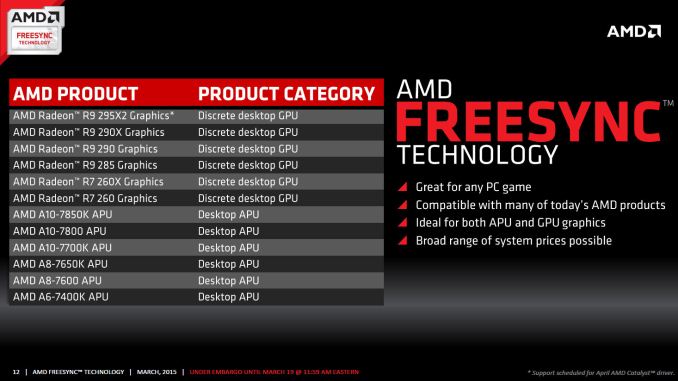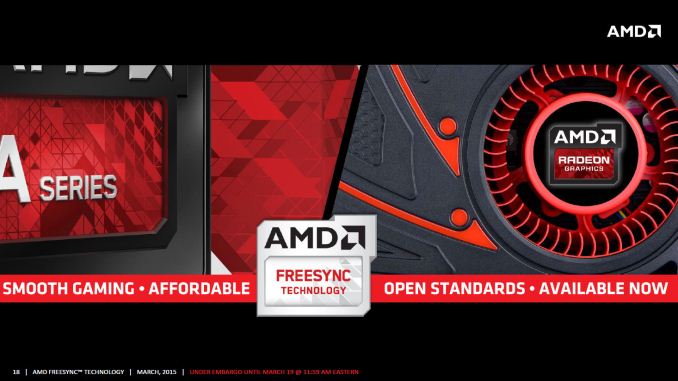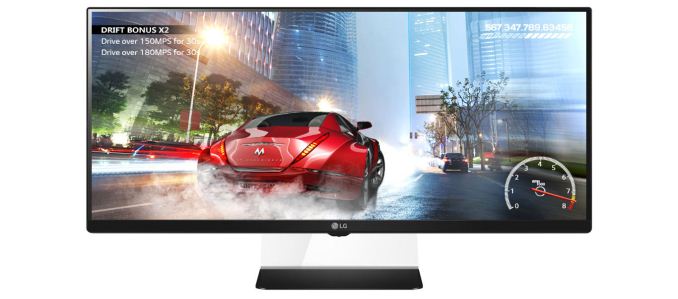The AMD FreeSync Review
by Jarred Walton on March 19, 2015 12:00 PM ESTClosing Thoughts
It took a while to get here, but if the proof is in the eating of the pudding, FreeSync tastes just as good as G-SYNC when it comes to adaptive refresh rates. Within the supported refresh rate range, I found nothing to complain about. Perhaps more importantly, while you’re not getting a “free” monitor upgrade, the current prices of the FreeSync displays are very close to what you’d pay for an equivalent display that doesn’t have adaptive sync. That’s great news, and with the major scaler manufacturers on board with adaptive sync the price disparity should only shrink over time.
The short summary is that FreeSync works just as you’d expect, and at least in our limited testing so far there have been no problems. Which isn’t to say that FreeSync will work with every possible AMD setup right now. As noted last month, the initial FreeSync driver that AMD provided (Catalyst 15.3 Beta 1) only allows FreeSync to work with single GPU configurations. Another driver should be coming next month that will support FreeSync with CrossFire setups.
Besides needing a driver and FreeSync display, you also need a GPU that uses AMD’s GCN 1.1 or later architecture. The list at present consists of the R7 260/260X, R9 285, R9 290/290X/295X2 discrete GPUs, as well as the Kaveri APUs – A6-7400K, A8-7600/7650K, and A10-7700K/7800/7850K. First generation GCN 1.0 cards (HD 7950/7970 or R9 280/280X and similar) are not supported.
All is not sunshine and roses, however. Part of the problem with reviewing something like FreeSync is that we're inherently tied to the hardware we receive, in this case the LG 34UM67 display. Armed with an R9 290X and running at the native resolution, the vast majority of games will run at 48FPS or above even at maximum detail settings, though of course there are exceptions. This means they look and feel smooth. But what happens with more demanding games or with lower performance GPUs? If you're running without VSYNC, you'd get tearing below 48FPS, while with VSYNC you'd get stuttering.
Neither is ideal, but how much this impacts your experience will depend on the game and individual. G-SYNC handles dropping below the minimum FPS more gracefully than FreeSync, though if you're routinely falling below the minimum FreeSync refresh rate we'd argue that you should lower the settings. Mostly what you get with FreeSync/G-SYNC is the ability to have smooth gaming at 40-60 FPS and not just 60+ FPS.
Other sites are reporting ghosting on FreeSync displays, but that's not inherent to the technology. Rather, it's a display specific problem (just as the amount of ghosting on normal LCDs is display specific). Using higher quality panels and hardware designed to reduce/eliminate ghosting is the solution. The FreeSync displays so far appear to not have the same level of anti-ghosting as the currently available G-SYNC panels, which is unfortunate if true. (Note that we've only looked at the LG 34UM67, so we can't report on all the FreeSync displays.) Again, ghosting shouldn't be a FreeSync issue so much as a panel/scaler/firmware problem, so we'll hold off on further commentary until we get to the monitor reviews.
One final topic to address is something that has become more noticeable to me over the past few months. While G-SYNC/FreeSync can make a big difference when frame rates are in the 40~75 FPS range, as you go beyond that point the benefits are a lot less clear. Take the 144Hz ASUS ROG Swift as an example. Even with G-SYNC disabled, the 144Hz refresh rate makes tearing rather difficult to spot, at least in my experience. Considering pixel response times for LCDs are not instantaneous and combine that with the way our human eyes and brain process the world and for all the hype I still think having high refresh rates with VSYNC disabled gets you 98% of the way to the goal of smooth gaming with no noticeable visual artifacts (at least for those of us without superhuman eyesight).
Overall, I’m impressed with what AMD has delivered so far with FreeSync. AMD gamers in particular will want to keep an eye on the new and upcoming FreeSync displays. They may not be the “must have” upgrade right now, but if you’re in the market and the price premium is less than $50, why not get FreeSync? On the other hand, for NVIDIA users things just got more complicated. Assuming you haven’t already jumped on the G-SYNC train, there’s now this question of whether or not NVIDIA will support non-G-SYNC displays that implement DisplayPort’s Adaptive Sync technology. I have little doubt that NVIDIA can support FreeSync panels, but whether they will support them is far less certain. Given the current price premium on G-SYNC displays, it’s probably a good time to sit back and wait a few months to see how things develop.
There is one G-SYNC display that I’m still waiting to see, however: Acer’s 27” 1440p144 IPS (AHVA) XB270HU. It was teased at CES and it could very well be the holy grail of displays. It’s scheduled to launch next month, and official pricing is $799 (with some pre-orders now online at higher prices). We might see a FreeSync variant of the XB270HU as well in the coming months, if not from Acer than likely from some other manufacturer. For those that work with images and movies as well as playing games, IPS/AHVA displays with G-SYNC or FreeSync support are definitely needed.
Wrapping up, if you haven’t upgraded your display in a while, now is a good time to take stock of the various options. IPS and other wide viewing angle displays have come down quite a bit in pricing, and there are overclockable 27” and 30” IPS displays that don’t cost much at all. Unfortunately, if you want a guaranteed high refresh rate, there’s a good chance you’re going to have to settle for TN. The new UltraWide LG displays with 75Hz IPS panels at least deliver a moderate improvement though, and they now come with FreeSync as an added bonus.
Considering a good display can last 5+ years, making a larger investment isn’t a bad idea, but by the same token rushing into a new display isn’t advisable either as you don't want to end up stuck with a "lemon" or a dead technology. Take some time, read the reviews, and then find the display that you will be happy to use for the next half decade. At least by then we should have a better idea of which display technologies will stick around.













350 Comments
View All Comments
lordken - Thursday, March 19, 2015 - link
mmh your point is? ofc if you have AMD you can only get freesync because if nothing else nvidia kept gsync for themself. What did you try to say? Nvidia is fragmenting monitor market.dragonsqrrl - Thursday, March 19, 2015 - link
My point is that Nvidia currently has more options for variable refresh rate tech, on top of a much larger install base, than AMD. It often helps to read a response in the context of the comment it's responding to. If you can't see how that's a relevant response to FriendlyUser's comment, then I can't help you.chizow - Tuesday, March 24, 2015 - link
Exactly, yet AMD fans and surprisingly, even the author Jarred (who should know better), would have you believe G-Sync somehow faces the uphill battle?JeffFlanagan - Thursday, March 19, 2015 - link
Having Nvidia refuse to embrace a standard does not make overpriced Gsync devices "better." It's just Nvidia failing their users yet-again.They screwed me on stereoscopic 3D by dropping support for the $1K eMagin HMD when changing business partners, making it clear that they do not care to support their customers if not supporting them will drive sales of new displays. I won't get fooled again.
chizow - Thursday, March 19, 2015 - link
Nvidia failing their users, that's interesting. So they failed their users by inventing a tech the world had never seen before and bringing it to market some 18 months before the competition. Having owned and used an ROG Swift for the past 7 months which completely changed my gaming experience, I'd disagree with you.Nvidia once again did exactly what I expect them to do: introduce great new technology to improve their ecosystem for their users.
AnnihilatorX - Thursday, March 19, 2015 - link
For those 18 months yes, Nvidia was good. But now, It fails its customers because now, refusing to support the VESA standard, they are effectively limiting their choice of monitors and by forcing customers to pay a premium if they want smooth gameplay.chizow - Thursday, March 19, 2015 - link
No, they're reinforcing their position and rewarding their customers by sticking to and developing a technology they're invested in. Their customers will pay the premium as long as their solution is better, and the only way to continue to ensure it remains better is to continue investing and developing it. Nvidia has already said they aren't done improving G-Sync, given how awesome it has been in its first incarnation, I can't wait to see what they have in store.Meanwhile, FreeSync is a good introduction into VRR for AMD, let's hope they continue to invest the same way Nvidia has to make sure they produce the best product they can for their users.
maximumGPU - Friday, March 20, 2015 - link
you can't possibly believe that, it's ridiculous!rewarding their customers by making them pay a premium for an end result that's clearly not noticeably different from the free alternative??
It's really business 101: they had the market cornered and they could charge whatever they want, fair play to them and well done.
But now when an equally good free open standard alternative comes into play, not adopting it IS a complete disregard to their customers. I own nvidia gpus (sli) now, and i DON'T want to pay for their solution after seeing what freesync can do. Not providing me with that option simply makes me a disgruntled customer that'll take my business elsewhere.
The problem is people like you who can't see that continue to blindly buy into it, making them reluctant to change their stance as long as the money rolls in. They'd drop gsync in an instant if no one buys their overpriced tech, and we'd all be better for it.
chizow - Friday, March 20, 2015 - link
And you can't possibly believe that can you? Read some actual reviews that clearly show right now FreeSync is the inferior solution.silverblue - Friday, March 20, 2015 - link
Besides the PCPerspective review (which, like this one, is a work-in-progress anyway), please provide links to these reviews (plural, as stated).